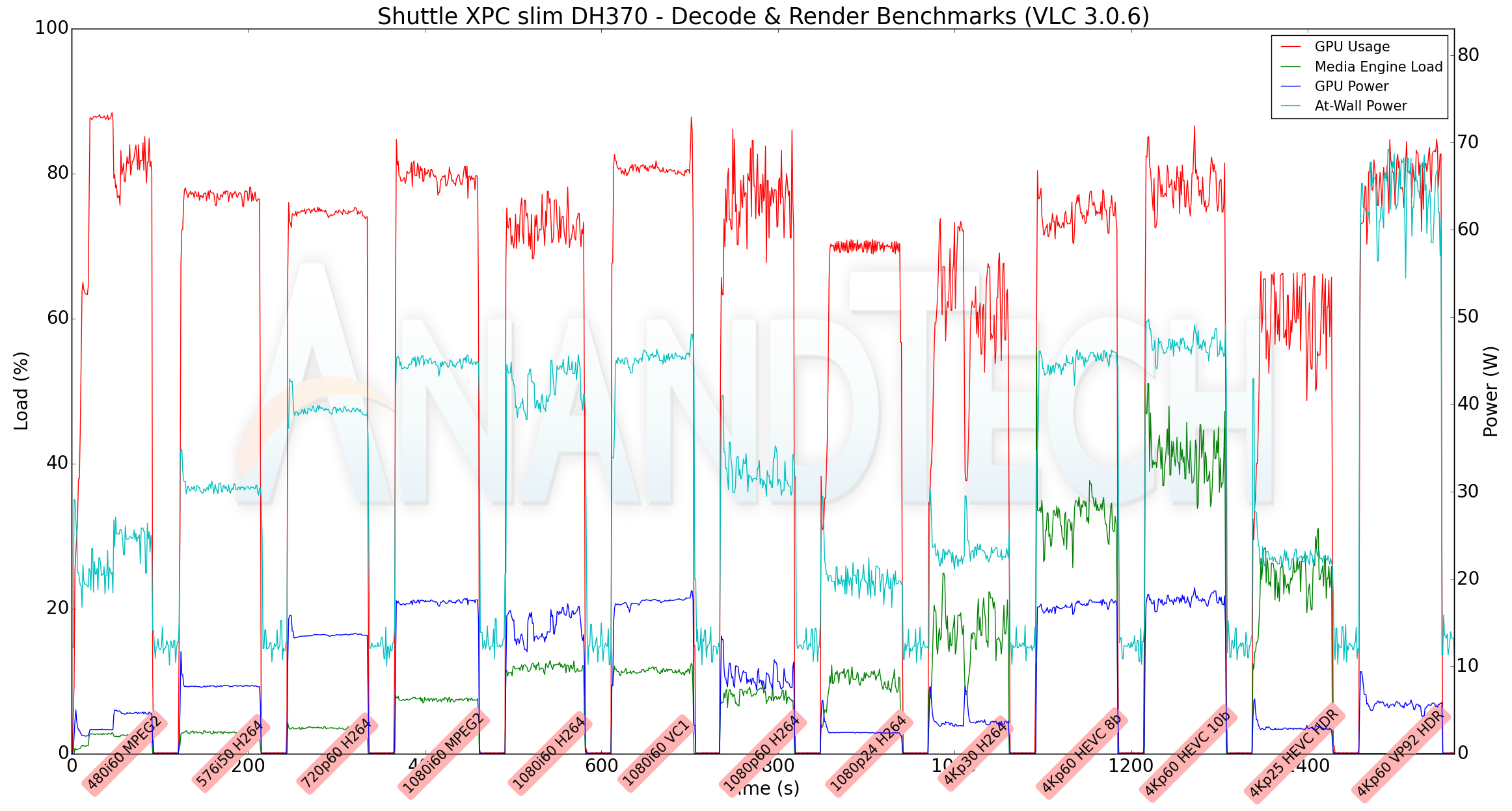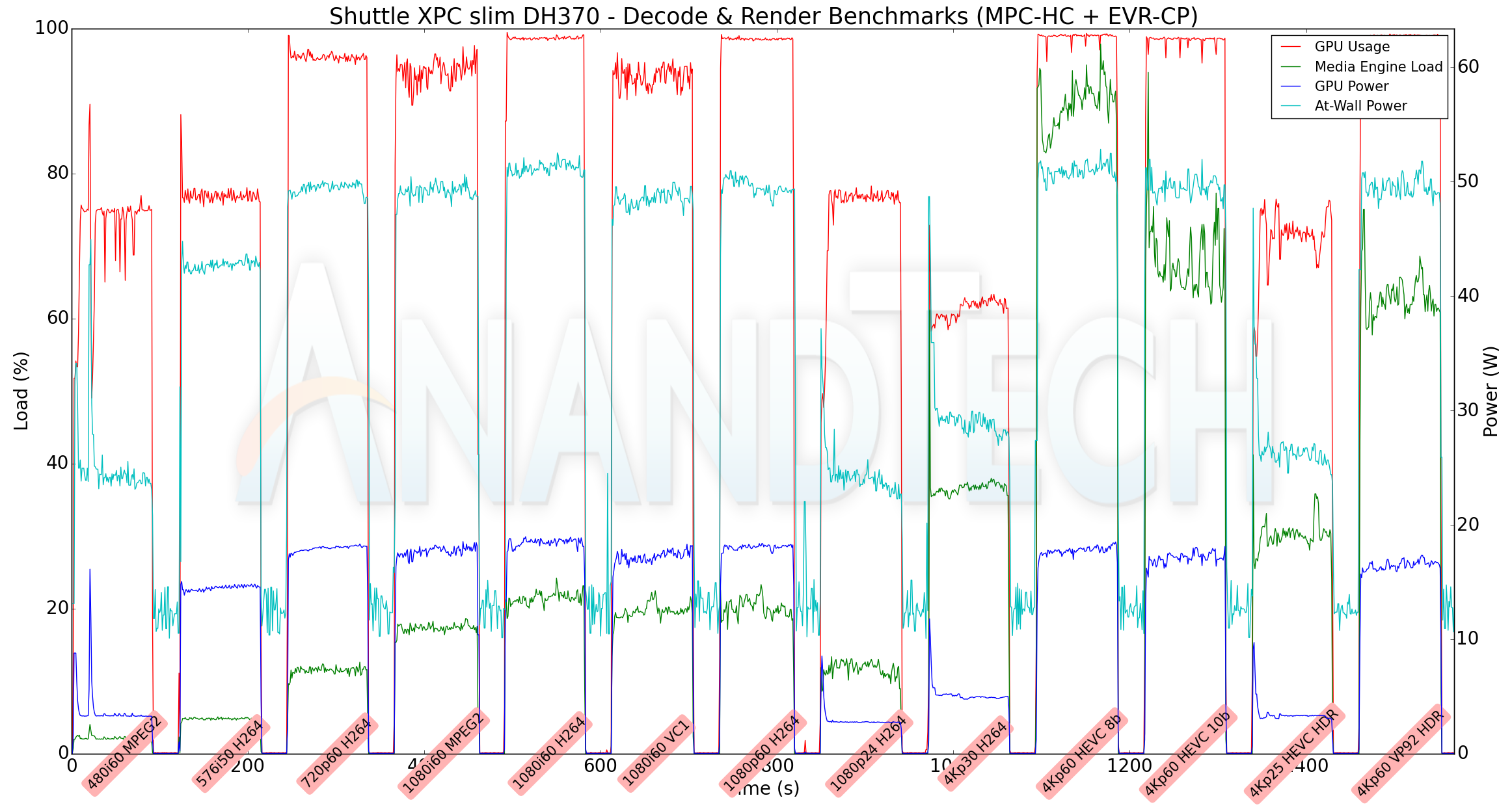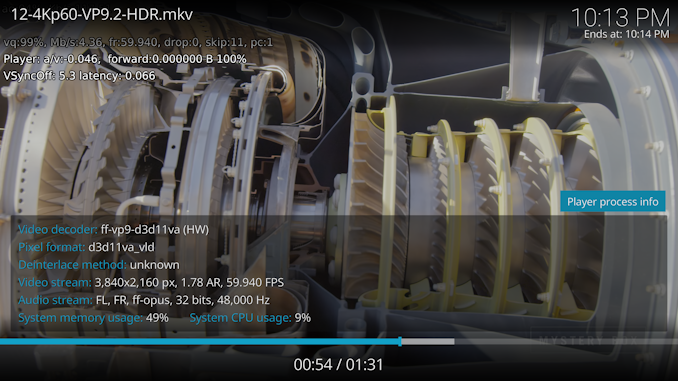Shuttle XPC slim DH370 mini-PC Review: A Compact Digital Signage Powerhouse
by Ganesh T S on May 6, 2019 8:00 AM ESTHTPC Credentials - Local Media Playback and Video Processing
Evaluation of local media playback and video processing is done by playing back files encompassing a range of relevant codecs, containers, resolutions, and frame rates. A note of the efficiency is also made by tracking GPU usage and power consumption of the system at the wall. Users have their own preference for the playback software / decoder / renderer, and our aim is to have numbers representative of commonly encountered scenarios. Towards this, we played back the test streams using the following combinations:
- MPC-HC x64 1.8.5 + LAV Video Decoder (DXVA2 Native) + Enhanced Video Renderer - Custom Presenter (EVR-CP)
- MPC-HC x64 1.8.5 + LAV Video Decoder (D3D11) + madVR 0.92.17 (DXVA-Focused)
- MPC-HC x64 1.8.5 + LAV Video Decoder (D3D11) + madVR 0.92.17 (Lanczos-Focused)
- VLC 3.0.6
- Kodi 18.1
The thirteen test streams (each of 90s duration) were played back from the local disk with an interval of 30 seconds in-between. Various metrics including GPU usage and at-wall power consumption were recorded during the course of this playback. Prior to looking at the metrics, a quick summary of the decoding capabilities of the Intel UHD Graphics 630 is useful to have for context.
The GPU can provide hardware acceleration for all contemporary codecs.
All our playback tests were done with the desktop HDR setting turned on. It is possible for certain system configurations to have madVR automatically turn on/off the HDR capabilities prior to the playback of a HDR video, but, we didn't take advantage of that in our testing.
VLC and Kodi
VLC is the playback software of choice for the average PC user who doesn't need a ten-foot UI. Its install-and-play simplicity has made it extremely popular. Over the years, the software has gained the ability to take advantage of various hardware acceleration options. Kodi, on the other hand, has a ten-foot UI making it the perfect open-source software for dedicated HTPCs. Support for add-ons make it very extensible and capable of customization. We played back our test files using the default VLC and Kodi configurations, and recorded the following metrics.
| Video Playback Efficiency - VLC and Kodi | |||

VLC is able to play back all streams with hardware acceleration - GPU usage less than 80% and media engine load less than 40% - except for the VP9 Profile 2 video. At-wall power consumption ranges from around 20W for the 1080p24 H.264 stream to 45W for the 4Kp60 HEVC streams. In the software decode case, we have the at-wall number sooting up to 65W. Kodi 18.1, on the other hand, is uniformly good. All streams, including the VP9.2 one, are played back with hardware acceleration and no dropped frames.
The GPU and media engine usage do not cross 80% for any of the files. The at-wall power consumption is around 28W - 32W depending on the stream/
MPC-HC
MPC-HC offers an easy way to test out different combinations of decoders and renderers. The first configuration we evaluated is the default post-install scenario, with only the in-built LAV Video Decoder forced to DXVA2 Native mode. Two additional passes were done with different madVR configurations. In the first one (DXVA-focused), we configured madVR to make use of the DXVA-accelerated video processing capabilities as much as possible. In the second (Lanczos-focused), the image scaling algorithms were set to 'Lanczos 3-tap, with anti-ringing checked'. Chroma upscaling was configured to be 'BiCubic 75 with anti-ringing checked' in both cases. The metrics collected during the playback of the test files using the above three configurations are presented below.
| Video Playback Efficiency - MPC-HC with EVR-CP and madVR | |||

The experience with MPC-HC and the latest Intel drivers (v6709) couldn't be more starkly different from what we experienced with the Bean Canyon NUC. The VP9 Profile 2 stream apparently plays back with hardware acceleration, but, suffers from plenty of dropped frames. The GPU power consumption numbers also seem off-the-charts, compared to what we saw with Kodi. This translates to higher at-wall power consumption in the 50W range even for streams that are decoded with hardware acceleration. Given this state with the lean EVR-CP renderer, the less said about the madVR configurations, the better.
Overall, Kodi 18.1 turned out to be the perfect media player application for use in the Shuttle XPC slim DH370.












37 Comments
View All Comments
timecop1818 - Monday, May 6, 2019 - link
Intel CPUs only have native DisplayPort output, not HDMI (licensing?). Nothing is technically preventing fullly complaint HDCP 2.2 path when using the MCDP part - unless shuttle cheaped out and didn't include the keys? Anyway i never looked into this as HDMI port is never something I'm looking for in a PC. I'm curious what exactly prevents the playback, as the same part (or a similar one from Parade tech) is what would be used inside a USBC to HDMI 2.0 cable as well.ganeshts - Monday, May 6, 2019 - link
All three display outputs support HDCP 2.2Intel supports HDMI, but, only 1.4a as of now. If OEMs want to put a HDMI 2.0a port, then, that HDMI capability of the Intel CPU is left un-used.
Some LSPCons do not do Stereoscopic 3D forwarding, which results in the loss of 3D capabilities.
rchris - Monday, May 6, 2019 - link
Thanks for a good review. But please include physical dimensions; particularly important when you're reviewing a compact system. The volume specs are nice, but not sufficient. Yes, they are available at the "Full Specifications" link, but would be more helpful to be in your article.Guspaz - Monday, May 6, 2019 - link
Be wary of Shuttle claims that their systems support standard motherboards. I bought a Shuttle XPC SZ77R5. Years later, the motherboard died and Shuttle wanted an absurd amount of money for the replacement (enough to buy a whole new computer). They claimed in the advertising for the system that it was "easily" upgradable with any standard mini-itx motherboard. In fact, the product website STILL says that.Three problems: the case uses a non-standard motherboard standoff height, and does not include any standoffs. There are a few of them directly welded to the chassis, but only enough for Shuttle motherboards, more are required for a mini-ITX board. I couldn't even find any of the right height online to buy, short of ordering them in bulk from China and waiting a few months. Instead, I had to take standard brass motherboard standoffs and filed them down by hand. It took hours.
Second: the included power supply didn't have a full-width power connector that mini-ITX motherboards required. Luckily, the missing pins were just for providing power, so they seem to be in the "strongly recommended but technically not required" category, and it worked OK without them.
Third: Shuttle motherboards don't have the CPU in the same location as a mini-ITX motherboard, so the system's custom heatpipe-based cooling system must be thrown out and replaced by traditional air cooling, which is less effective.
Death666Angel - Monday, May 6, 2019 - link
Well, mITX motherboards don't have the CPU sockets in the same location, so that point is moot. And all I just read about their advertising the ITX compatiblity (granted, I only found the German site) is that they said you can use mITX motherboards without having to modify the case. And that seems right, doesn't it?Guspaz - Wednesday, May 8, 2019 - link
It was not really true for the SZ77R5, no. Because short of fabricating custom mounting hardware like I did, you would have needed to modify the case with a deemed to install an mITX board. Requiring mounting hardware that does not exist is far from the easy upgradability they claimed. Now, hopefully this isn’t the case with the product that is the subject of this anandtech article. But I’ve been burned by them before.Guspaz - Wednesday, May 8, 2019 - link
*with a dremel, not a “deemed”timecop1818 - Monday, May 6, 2019 - link
Dude this is a completely non-standard SFF motherboard that doesn't follow any particular layout or spec. Do you complain that Intel NUC doesn't fit into Mini ITX board? There are no claims made anywhere that this board is user replaceable.0ldman79 - Tuesday, May 7, 2019 - link
"Mini-ITX Mainboard SupportShuttle expands the capabilities of its R chassis, adding support for Mini-ITX mainboards (17 x 17cm or 6.7 x 6.7 inches). The Shuttle chassis can go beyond the Shuttle mainboard, so you can easily upgrade or downgrade the mainboard to your desire, without any modifications to the chassis."
http://global.shuttle.com/main/productsDetail?prod...
timecop1818 - Tuesday, May 7, 2019 - link
Yes and that link has nothing to do with the product reviewed here...